Dvergur (4e Race)
Dvergur[edit]
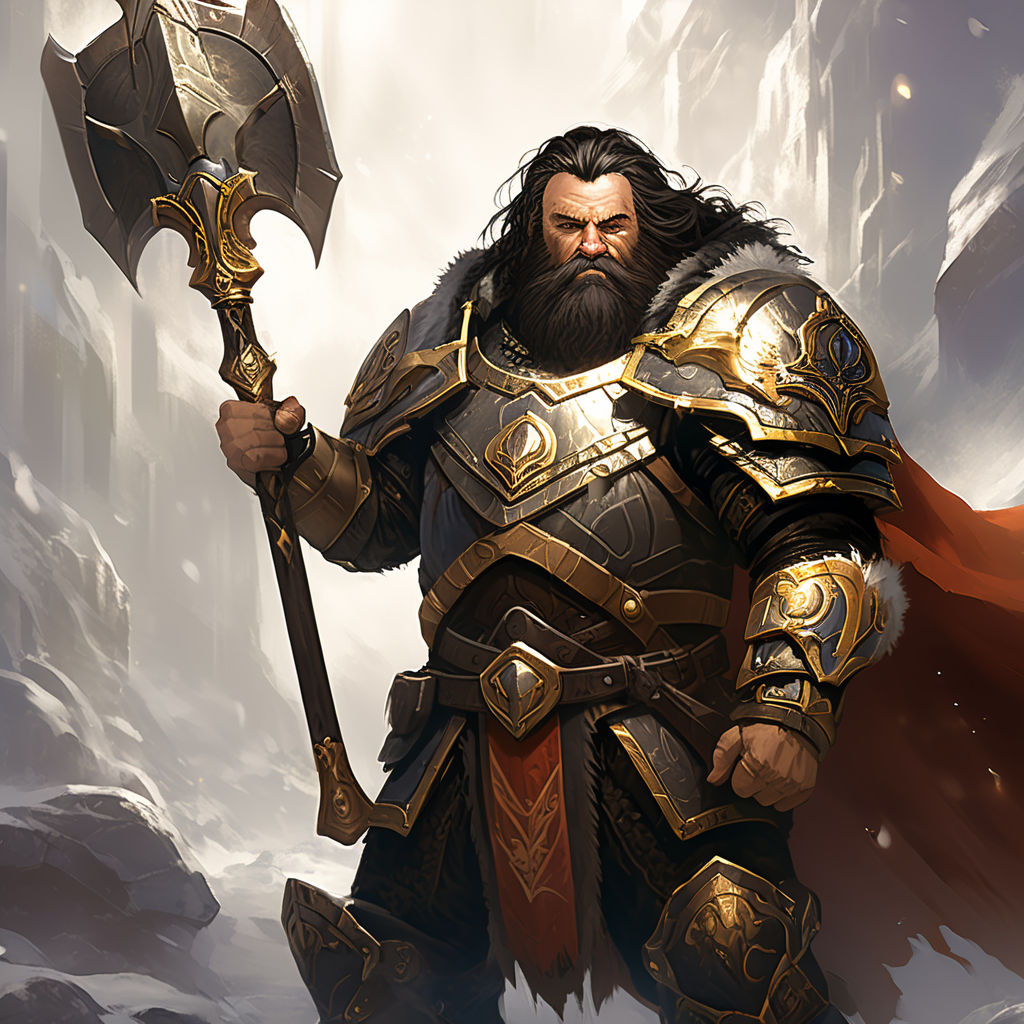
|
|---|
| AI Generated Art [1] |
Ambitious, driven, strong and proud, the Dvergur were once a common race and a precursor to the Dwarves, until a sudden shift in fate lead to their near extinction.
| Racial Traits |
| Average Height: 5´3 to 6'7 |
| Average Weight: 120–350 lb |
| Ability Scores: +2 to Strength, +2 to Wisdom or Constitution |
| Size: Medium |
| Speed: 6 squares |
| Vision: Low-light Vision |
| Languages: Common, Dwarven |
| Skill Bonuses: +2 Endurance, +2 Insight |
| Unencumbered Speed: You move at your normal speed even when it would normally be reduced by armor or a heavy load. Other effects that limit speed (such as difficult terrain or magical effects) affect you normally. When determining your normal load, heavy load, or maximum drag load (PH 222), treat your Strength score as 5 points higher. |
| Bonus Feat: You gain a bonus feat at 1st level. You must meet the feat’s prerequisites. |
| Dwarven Ancestry: For the purposes of meeting prerequisites, such as for feats or paragon paths, you qualify as a Dwarf and Human. |
| Dwarven Resilience: You can use your second wind as a minor action instead of a standard action. |
| Dvergur Ingenuity: You are treated as if you are a living construct, and may add warforged components as if you were a living construct. For the purposes of meeting prerequisites, you have the "living construct" racial trait. This means you can attach and embed components as if you were a warforged (see "Warforged Components," page 113 of the Eberron's Player Guide). |
Race Description[edit]
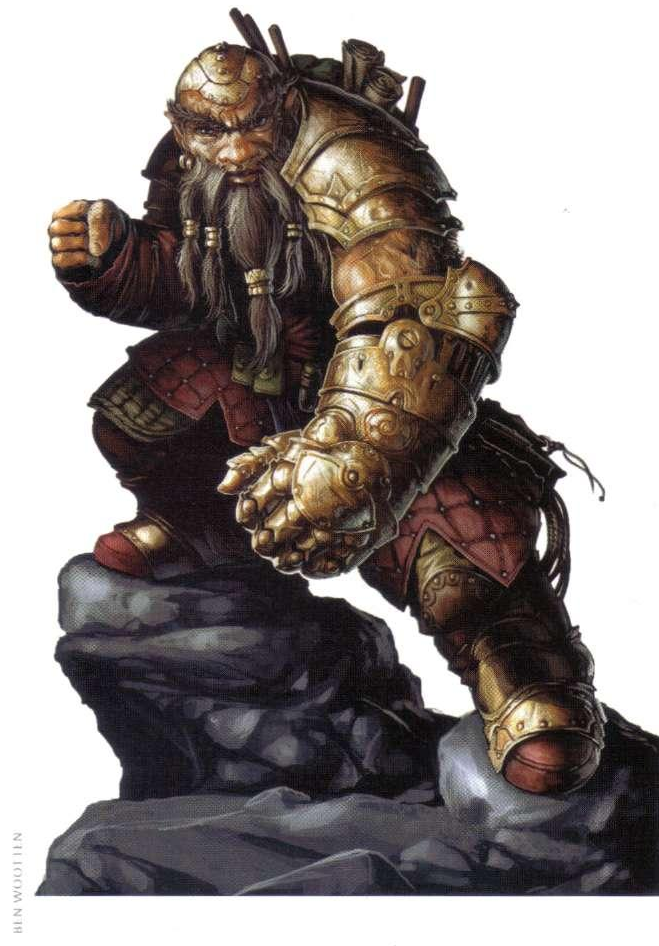
|
|---|
| Eberron's player guide, page 65 (Dungeons and Dragons book) |
The Dvergur were a strong, industrious, and ambitious race, producing many great castles, fortresses and cities. They were exceptionally strong, and closely resembled humans, except much larger and with what would know be associated with Dwarven features. They were tall and muscular, and very wide, appearing as if very tall Dwarves would. The Dvergur were a precursor race to many Dwarven species, being an offshoot of humans who eventually went a separate path. Although they were successful and industrious, they broke off in to many factions, and after many centuries of treacherous wars, were driven deeper underground or forced to the surface, where they evolved in to modern day dwarves. Few Dvergur survive today, and most are mistaken for Humans or unusually tall Dwarves, with their bloodline often diluted if they reach the surface. Only a few havens exist for them, largely ancient ruins of a now forgotten Kingdom of Du'all, which many believe to be abandoned, thus protecting the few remaining Dvergur. Most remain in secret, fearful their enemies in the Underdark or the Orcs would come in and slaughter the few remaining members of their race if they were ever exposed. Although the Dvergur wish to bring their race back to it's former glory, many have recognized the sheer impossible nature of this.
The Dvergur are unlike Dwarves in that they are quite large, tend to be much more serious and calm than the more jovial Dwarves, and largely are relegated to a small number of hidden settlements not well known by the rest of the world. They produced large volumes of technologically advanced equipment for their era, and managed to mine large volumes of the mineral Mithril, which the Dwarves used to fashion much of their equipment. The Dvergur were among the first humanoids to mine this rare material, and eventually developed features to help them mine it. The Dvergur unlike Dwarves have a heavier emphasis on Swords and Blades rather than hammers, being master swordsmiths and forgers of sophisticated steel and mithril weaponry and tools. They are tinkerers, and manufacture gadgets as well as blades and hammers, and other tools. They made very sophisticated and complex tools, and used them to build large ancient cities and buildings scattered around the world. They are directly responsible for the rise of the Dwarves as well as the majority of ancient mysterious cities few truly understand.
The Dvergur were not a part of the Underdark, however they strayed too far from their homes and dug so deep in to caves they began to concern many Underdark leaders, particularly Lolth. The Spiderqueen of the Damned, she ordered the destruction of the Dvergur, who were uniquely vulnerable at the time to attacks as they were spread quite thin. Furthermore the Dvergur relied heavily on technology and enchanted magical constructs to do much of their work, making them unadapted to fighting the relentless onslaught of Lolth. The Dvergur perhaps ironically had their creations outlast them, with the Warforged still surviving to this day in many forms, and their Dwarven cousins who largely absorbed them in to their ranks to be breed out almost entirely as their numbers dwindled. The Dvergur did not succumb to slavery like many Dwarves, however they were all but completely wiped out or absorbed in to Dwarf society by the constant purges by the Underdark creatures. The Dvergur's greatest strength, their curiosity and emphasis on technology, would ultimately be their undoing as they attracted the attention of many dark and destructie Gods.
- to be a decisive, powerful Race with an ancient history
- to have features like both a Dwarf and a human
- to be able to excel at strength based classes, such as the Paladin, Cleric, Fighter, Ranger, Warlord, Barbarian, Warden, and Runepriest classes.
Physical Qualities[edit]
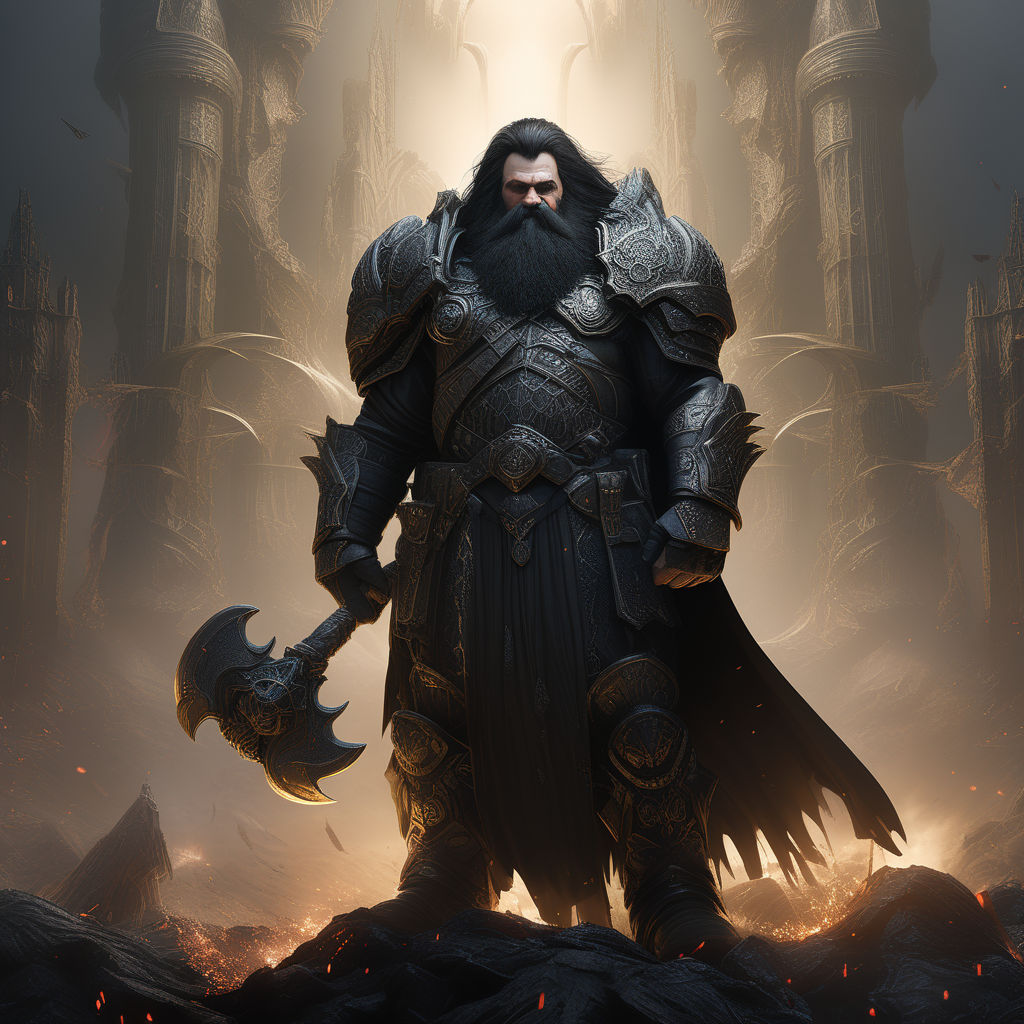
|
|---|
| AI Generated Art [2] |
Dvergur closely resemble Dwarves in many ways, but are much taller and wider, and are around the same height as humans but proportionately have builds more similar to Dwarves. They range from the size of an average human, to being extremely large, with some being up to 6'7 and 350 pounds of muscle. They are unusually large, especially for humans, and are incredibly stocky, broad shouldered and wide, being thicker and wider, even in their skeletal structure, than humans. Most grow large, bushy beards, and have sharp, beedy eyes, reminiscent of Dwarves. They are not quite as resilient of Dwarves, being stronger, but not quite as stocky. The Dwarves that survived the massacres of the invading armies were generally the most hardy and fit to survive, and due to shrinking food supplies and the need to move deeper in to protected areas, grew smaller as a result. The Size of the Dvergur was costly, as were their complex technology, which was not a luxury that could be afforded when starvation kicked in. Further, virtually all Dwarves are known to be able to eat contaminated and even poisoned food, giving them a fantastic means of survival, an adaptation most Dvergur did not have, and thus lead to their near extinction. Many Dwarves are a direct descendant of Dvergur, and the reason for their survival depends upon their unusually hardy nature.
Dvergur are not living constructs, however they due to their advanced technology commonly attached these components to their bodies. They were known for messing with gadgets and trinkets, and frequently forged these components. Despite lacking the features for it, Dvergur were commonly artificers, and had a culture of developing complex technology, a feature lost to the ages. They were known to build many of their pieces of equipment out of mithril, and animate them using magic. The Dvergur would send living constructs to go mine for them, and the Dvergur were responsible for the creation of many of the first Warforged, who use the same components the Dvergur can attach to themselves. Dvergur as a result are often seen with complex mechanical components attached to their bodies, even though they are not themselves a living construct. Dvergur live and age at approximately the same rate as Dwarves, despite their closer appearance to humans. They also have many of the same mannerisms and characteristics of Dwarves, from their beards to their stocky body profile. Although many Dwarves directly descend from the Dvergur, Dwarves existed at the same time as the Dvergur, and curiously had a parallel development to them. Modern Dwarves share large amounts of Dvergur ancestry, but were not derived directly from the Dvergur. The Dvergur were absorbed by the other Dwarves and taken in, and due to their small numbers over many generations were eventually breed out, with few Dwarves possessing obvious or overt Dvergur characteristics. This is similar to Neanderthals and humans. Virtually all modern Dwarves have some latent Dvergur ancestry, however those with the least amount of the Duergar, who were reflexively hostile to the Dvergur and killed many on sight, being agents of the Underdark. The Duergar especially hate the Dvergur, as they have been tasked with their Gods with their complete destruction, particularly Lolth, the Spider queen, who revels in the destruction of others and say the Dvergur's expansion as a future threat to her empire.
Living Constructs and Mechanical aptitude[edit]
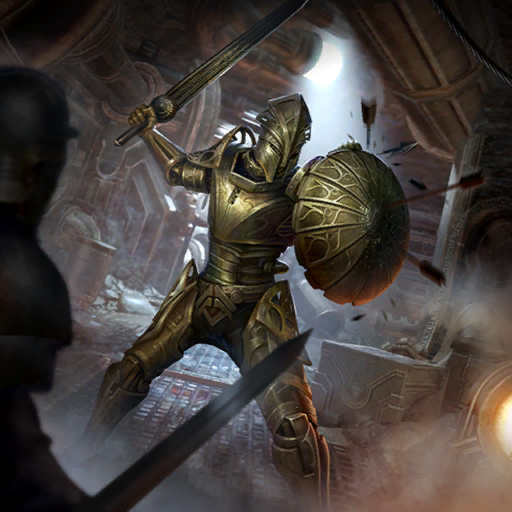
|
|---|
| Legends Art [3] |
The Dvergur were excellent craftsmen, and produced a variety of tools to help them mine the caves and parts of the Underdark they lived in, including living constructs. Living constructs were first used to mine the caves for the Dvergur who lacked the resilience to go in to certain locations themselves, or did not wish to succumb to it's dangers, and later they were enhanced to improve their combat capabilities to fight off the hordes of Underdark creatures. Dvergur made much of their creations with a combination of bronze, silver, gold, steel, mithril, and a small amount of adamantium, however they animated them with magic. Usually, the soul of a living creature would be saved from permanent death and then tied to a living construct, such a crab with a crab like robot, or a fallen soldier tied to a Warforged body. Although magically and to some extent divinely animated, there still required a suitable body of comparable size and shape to the host soul, and a degree of mechanical competency and similarity to function. Many features of Dvergur creations were designed to improve the efficiency of designs, and so features like a series of complex springs to make them more maneuverable (such as Götz von Berlichingen's iron hand in real life) or spinning disks to retain power like a flywheel were utilized to allow the mechanical body to move on it's own. However, the direction of movement and the goals were almost always determined by a captured soul, that was tied to the physical device. In other cases, mechanical devices would be psychically controlled by the user, but the same complex series of springs and mechanical parts were used to make the movement more easy. For example, it is much easier to psychically control a repeating crossbow to load and fire than it is to make a crossbow bolt appear from thin air and fire at the same speed, making many of the designs more efficient in their use of magic rather than being purely animated by magical forces. Magic would still be required to aim and fire the bow, but the crossbow itself would rely on mechanical components to get to this part. Dvergur typically used psychically controlled components, which are difficult to learn how to use without precursor knowledge or an innate aptitude for these types of operations.
The Warforged in particular were created near the end of the Dvergur's existence, created to fight the overwhelming numbers of the Underdark creatures swarming their homes. They were gifted with high levels of intelligence and closely tied to real humanoid souls, and given a degree of self autonomy that prior mining living constructs rarely had. They were also built for war, and outfitted with weapons and equipment the Dvergur often used themselves. Many of the warforged components are directly applicable to Dvergur themselves, who wore them like accessories or armor, integrated them in to the body like piercings or tattoos, or even completely replaced body parts which were often damaged or removed in desperate fighting in the Underdark. Most warforged have no recollection of their creation, and many more were later copied by other magic users and created without the assistance of the Dvergur, leading to their continued survival or repurposing despite being an initial creation by the Dvergur. As a result many Dvergur are tied to the warforged and view them as the way a parent might view a child, where as many warforged have no idea that the Dvergur even exist other than through small snippets of memories from their past lives, if they had one. Some warforged still hail from the time of the Dvergur, being dormant or even remaining fighting for many thousands of years, however few with knowledge of this time period exist to today.
The Dvergur produced a variety of mechanical creations, from digging machines, mining equipment, guards and soldiers, and crab-like creatures to explore the caves for them and serve as scouts, and occasionally attack their enemies. Dvergur often kept these self animated machines as pets, and would use them as assistants in their work or laboratories. Dvergur technologically was still quite limited by their environment, and is largely tied to magic use, making them as skilled at magical creations as at crafting machines. The machines are simple and rely heavily on mechanical components, rather than electrical one's. Some are even powered by steam or heat, although these are more rare, and some work similar to sterling engines. Most are filled with a complex series of gears and springs attached to animal-like joints and features to help facilitate movement. Most were made out of largely mithril and bronze, and other parts of them were put together or brazed with gold and silver. Air tight airsacs are sometimes used to store power or energy for movements instead of springs, producing a hydraulic type effect. A variety of methods were used, and a particularly innovative Dvergur might be able to come up with a creation based on new methods (should a DM permit).
Both Mithril and Adamantium are used in particular to animate the living constructs, as well as make them stronger. Adamantium in particular is known for conducting and storing magic, allowing it to be used to store animation spells practically indefinitely, and is absolutely critical to the core components of a living construct. Virtually all living constructs require some amount of Adamantium, which must be mined and is extremely rare, or it must be created through an exhaustive spell which converts mithril and steel to Adamantium. Only trace amounts are required to animate must living constructs, and generally a small, thin wire extending to most the parts of the creation are necessary. As long as the animation spell is properly provided, and a sufficient amount of adamantium, nearly anyone can create a living construct. However these spells are rarely known and adamantium rare and expensive, making the mass production of living constructs like in the old Dvergur mining days uncommon. Typically only particularly skilled sorcerers and wizards are capable of producing living constructs and only after great difficulty, although some spend time to relearn the ancient arts. Artificers are also typically capable of creating living constructs, and especially can create weapons meant to be used by them, animated and enhanced by magic.
Dvergur Feats[edit]
Dvergur's meet the perquisites for Dvergur feats and abilities, as well as Dwarves and Humans.
| Name | Description |
|---|
| Name | Description |
|---|
| Name | Description |
|---|
| Name | Description |
|---|---|
| Light's Perseverance | You gain proficiency with all heavy and lights blades and a scaling +1/2/3 feat bonus to damage when using them. |
| Name | Description |
|---|
| Name | Description |
|---|---|
| Sudden Spell | Use arcane at-will power as free action when you spend an action point |
| Name | Description |
|---|---|
| Dark Iron Dwarf | You gain Dark vision and a +2 bonus to visual perception rolls made in the dark. |
| Dark Iron Hide | You gain a resistance to all damage equal to 2/3/5 at each paragon tier, and temporary hitpoints equal to 3 + 1/2 your level at the start of each encounter. |
| Dark Iron Warrior | You gain access to certain features and special Dark Iron At-will, Utility, Encounter and Daily powers |
| Duergar Weapon Proficiency | You gain proficiency with all picks and axes, and a scaling +1/2/3 bonus to attack rolls with them. |
| Duergar Weapon Training | When you use a pickaxe for a weapon attack, you may target the fortitude defense instead of the original defense. |
| Dwarven Resilience | You gain an additional use of your second wind and gain a +1 bonus to attack rolls when you use it. |
| Name | Description |
|---|
| Name | Description |
|---|
Dvergur Utility Powers[edit]
Back to Main Page → 4e Homebrew → Powers → Dvergur Powers
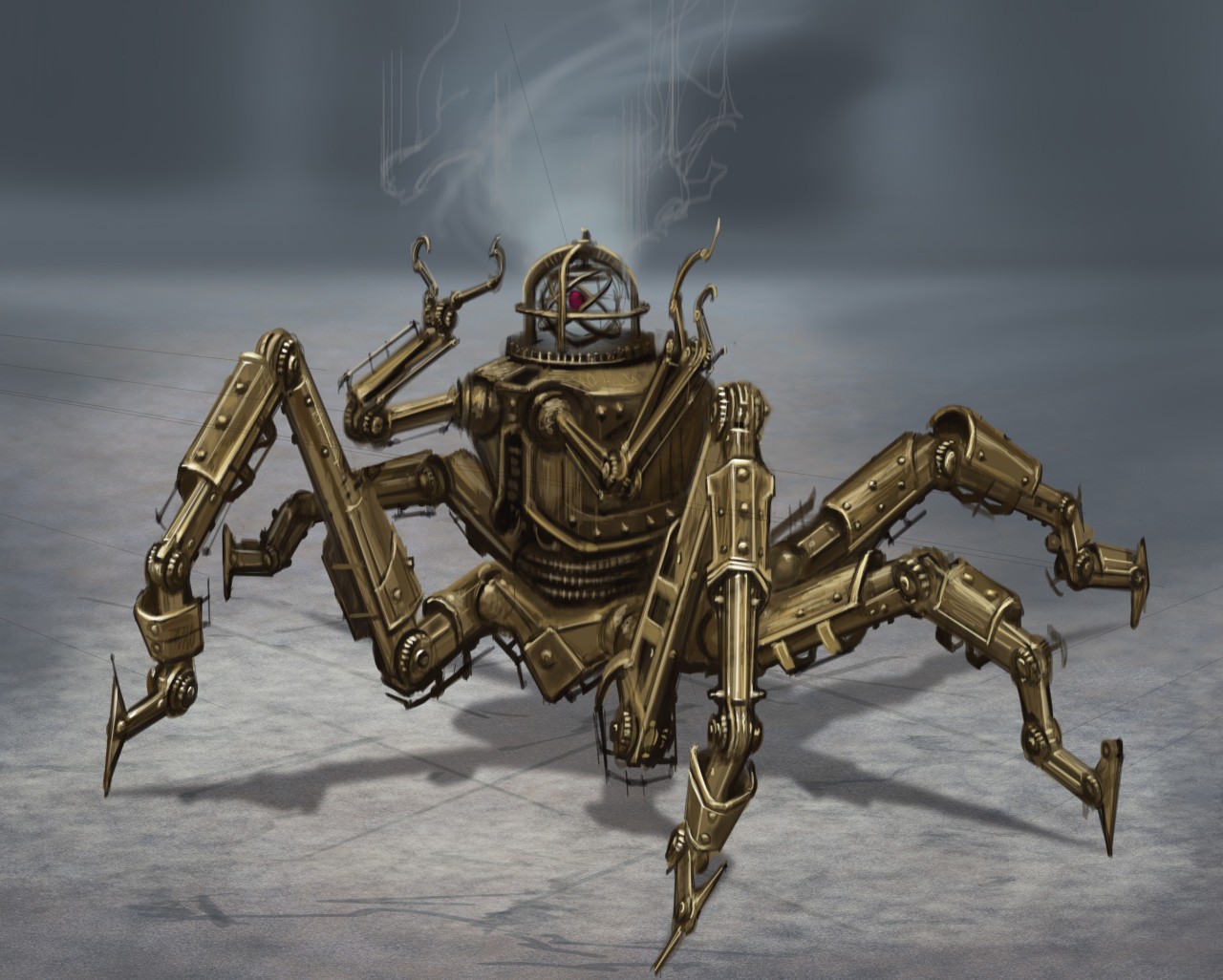
|
|---|
| By Adam Adamowicz, concept art for Skyrim [4] |
Notes[edit]
This race, despite being claimed to being a precursor to Dwarves, is a completely original race not found in any other D&D source. It was developed to be similar to the Dwemers in Skyrim in concept, but completely different in many other ways. It is meant to fulfill a role in a campaign setting of my own design, known as the Scarlet Crusade. I feel such a race is sufficiently different from Dwarf or Humans to be portrayed by them. Especially in regards to warforged components, which more so reflect their technological sophistication.
Back to Main Page → 4e Homebrew → Character Options → Racial Trait Variants
